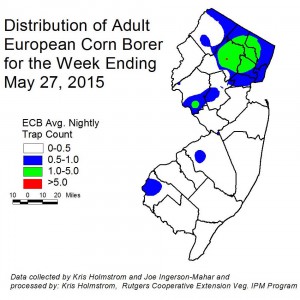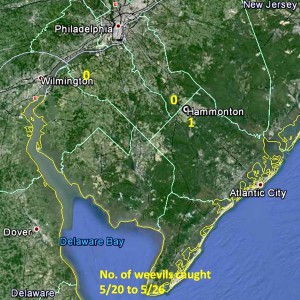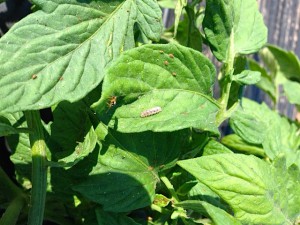Sweet Corn
European corn borer (ECB) adults are being captured with increasing frequency now. Areas of highest activity now include parts of Hunterdon and Morris counties (see ECB map). Within the past 3 days, IPM personnel have found low level ECB infestations in some of the earliest sweet corn plantings. At present, reports of feeding are from Ocean and Somerset counties, however it is likely that feeding is occurring in many early plantings to the south.Be sure to begin monitoring the earliest plantings for ECB feeding while they are still in the whorl stage. Consider treating when the number of infested plants in a 50 plant sample exceeds 12%. Feeding in the whorl stage will appear as numerous small holes (called “shot-hole”) on leaves, with damage present on consecutively younger leaves. As plants progress to pre-tassel, the actual larvae may be found in or on the emerging tassels. Any planting remaining at or above threshold as it proceeds to full tassel should be treated, as this is the last stage at which ECB larvae will be exposed and vulnerable to insecticidal sprays.
Often, early sweet corn plantings suffer from “split set”, in which germination does not occur in a uniform fashion. The result is a planting where all plants do not reach full tassel at the same time. This situation may require an extra tassel spray if there are several days difference in the time full tassel is reached on a significant number of the plants.
Insecticides that are acceptable in organic production include the spinosyn based material Entrust (IRAC-5) and Dipel (IRAC-11a). The 10G formulation of Dipel is particularly useful when granules can be dropped or broadcast such that they get into the whorls of corn plants. See the 2015 Commercial Vegetable Recommendations Guide for more insecticide choices.
For more information see:
| The highest nightly ECB catches for the previous week are as follows: | ||
| Denville 7 | Califon 1 | Medford 1 |
| Sergeantsville 2 | Cinnaminson 1 | Newton 1 |
| Woodstown 2 | Downer 1 | Pedricktown 1 |
| Allentown 1 | Little York 1 | South Branch 1 |
No corn earworm moths (CEW) were captured in blacklight traps this past week.
Peppers
Pepper transplants are now going into fields. At the same time, the first ECB flight is ongoing. Be sure to scout fields regularly for the presence of ECB egg masses. If two or more egg masses are found in a 50 plant (two leaves/plant) sample, consider treating even if no fruit are present. In the absence of fruit, ECB larvae will bore into the central stem, topping the plant. This will result in the loss of crown fruit on infested plants. Generally, where blacklight trap catches average one or more ECB per night (blue and green areas on the ECB map) and fruit are greater than ½” in diameter, insecticides are warranted. See the 2015 Commercial Vegetable Production Recommendations for materials useful in controlling ECB.
Pepper Weevil Report
Only one weevil was caught this past week near Hammonton (see pepper weevil trap catch map). Farmers who have pepper fields within 1.5 miles of a produce handling facility (processor, repacker, auction, etc.), or picks up produce from a terminal market should consider spraying their peppers as soon as the first bloom is set. Refer to the 2015 Commercial Vegetable Production Recommendations for recommended insecticides for adult pepper weevils.
Tomatoes
Many early tomato plantings are now in the field. Pruning and tying of plants is on-going. Remember that any event that results in contact with the plant causes numerous injuries to them. While these injuries heal, they serve as avenues of entry for bacterial pathogens that may be present either on the plants or in the field. Serious bacterial pathogens of tomato include bacterial leaf spot and bacterial canker. Both can result in unmarketable fruit, and canker can kill plants prior to the production of fruit if the infection occurs early enough.
Timing and rates for applications of copper and/or the plant defense activator Actigard are detailed in the 2015 Commercial Vegetable Production Recommendations. These products provide some suppression of bacterial pathogens. It is critical, however, that spread of bacterial organisms be limited as much as possible. Avoid working in fields when plants are wet. When work is to be done in more than one planting, always work from youngest to oldest plants. This prevents workers from transporting bacteria to younger plants, where infections can result in increased crop loss. Remember that the earlier a plant is infected by a bacterial pathogen, the more likely it is to produce unmarketable fruit.
Aphid populations have also begun to appear both in the field and in high tunnel tomatoes. These pests often form colonies beneath the surface of leaves and near growing points on the plant. While the plants consist primarily of vegetative growth without fruit, aphids are largely an insignificant pest. If no broad spectrum insecticides are used on the plants, the aphids generally are decimated by predators and parasites before becoming an economic problem.
This week, several low level field infestations were found with numerous predatory insects in association. Predators included syrphid (flower) fly maggots (see photo) and ladybird beetles. When scouting, take note not just of the aphid populations, but of the presence of these predators. Their appearance is a sign that the aphid population could soon decline as long as predators are not disrupted. Should aphid populations increase to a degree that their droppings are accumulating on the surface of developing fruit, an insecticide that specifically targets these pests may be necessary. See the 2014 Commercial Vegetable Production Recommendations for materials that are labeled for aphid control in tomatoes. Avoid broad spectrum insecticide classes such as synthetic pyrethroids as much as possible.
Brown Marmorated Stink Bug (BMSB)
One BMSB was captured in light traps this past week. As adult captures increase to 5/night in parts of the state, maps will be produced to show where activity is highest; information on scouting, crop injury and control will also be included.




